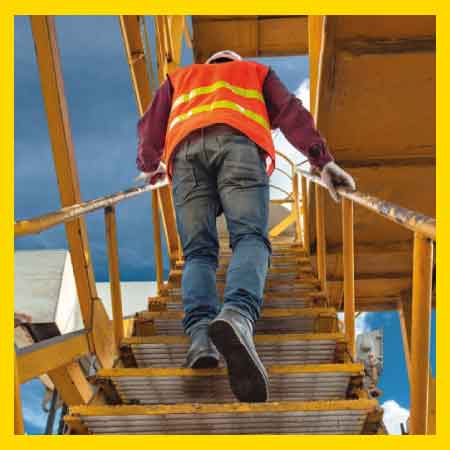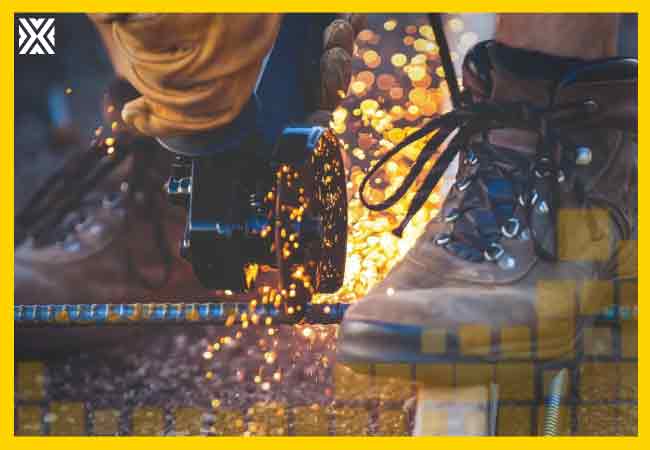Currency
July 04, 2019

Human beings are a marvel of natural engineering. Just like any piece of engineering, however, things can go wrong. Whilst this can happen naturally, it can also be of our own making, so taking steps to protect ourselves – and our workers – is of paramount importance.
In this article, let us focus on the feet: why they are important and how we can make our best efforts to protect them. Whilst our focus will be on the footwear itself, we will also discuss other measures to consider.
During our early years, our feet are one of the first things we learn to use. We kick them about aimlessly, having no idea of their purpose and function. Depending upon the individual, this learning process can then go through several stages. Some children realise they can kick their legs to push them along the floor, which can progress to shuffling on the bum, or more commonly crawling on the stomach. This is a delightful but equally terrifying sign for any parent, that the small defenceless bundle of joy that is their child, is imminently going to be set loose upon the world. That day comes when we learn to stand, then take our first tentative, and somewhat clumsy steps, and our parents suddenly have to hide or lock up everything!
Needless to say, after these early developmental years our feet become integral to our way of life. They can help move us over great distances through walking. We learn other methods of movement using our feet including jumping, climbing, and hopping. They allow us to balance (think of ballerinas, but not always so graceful), or even simply supporting us by allowing us to stand upright.

By not taking care of our feet, many issues can arise, particularly if we use the wrong footwear, or in some cases, no footwear at all. We are not just talking about the fashion faux pas of wearing socks with sandals; ill-chosen footwear can cause severe damage that can lead to lifelong consequences. These consequences are one of the things we will discuss today, as well as what we can do to prevent foot injury and other associated health issues, such as adapting the task, the work environment and so on. We will also look at some of the different types of foot protection available, discussing some of their features, technology, and what to consider during selection of footwear appropriate for your working environment or business.
An injury or issue with just one foot is bad enough, being extremely debilitating, limiting our independence and ability to move around freely. An issue with both feet would be a downright disaster. We would have total reliance on other people to assist us with mobility, and I am not just talking about walking.
Scaffolders and other people working at height would not be able to climb ladders. Athletes would have trouble running or jumping, or taking the strain when balancing, or lifting heavy weights. Some workers would be limited to specific jobs or roles, as foot issues would prevent them from performing certain tasks and accessing certain areas (scaffolding, tower cranes, confined spaces etc). Indeed, long term foot problems could even affect a person’s employability. A nightmare if that person is the only provider for their household, particularly if they are supporting a family. So, what kinds of injuries and issues are we talking about?
It could be something very simple, such as blisters, corns or hardened skin causing pain. Sprains, strains and other muscle injuries are also a common occurrence. It may be a water-related issue such as trench foot, or something related to temperature such as frostbite. Broken bones are also all too common.
Ultimately, however, partial or total amputation of the feet or toes is the worst case scenario. Some of these problems are easily solved with medication, simple remedies, physiotherapy, even just giving the injured party complete rest, ordering them to stay off their foot/feet for a certain amount of time. Other problems, however, would need a much more drastic approach, such as surgical intervention or the fitting of prosthetic limbs. An injured party may have to rely on the use of a cane, crutches or Zimmer frame (or Walker) in order to be able to walk around, whether this is during the recovery phase or becomes a permanent addition to their lives. Others with extremely limited or total loss of mobility would have to depend upon equipment such as wheelchairs or mobility scooters. Even something simple such as using stairs may require the use of a stair lift, or even the use of elevators, as the person can no longer use stairs at all.
These physical issues we have discussed are of course concerning. However, we should not make the mistake of ignoring the potential degradation of mental wellbeing, which would be associated with these injuries. Particularly, workers who suffer such injuries for the long term could become extremely frustrated at their inability to work, and indeed lead a normal life, leading to issues such as a drop in confidence, or increase in stress, anxiety and depression.
This “lack of confidence” and mental health effects could still influence an injured party, even if they return to work. The worker may be worried about whether or not the foot could take the stresses and strains that it was used to, prior to the injury occurring. I can speak from my own personal experience of having broken bones in my legs and feet on more than one occasion whilst playing football. Although I had the assurances of the doctors and physiotherapists that my bones had healed well, on each occasion it took me some months, and a great deal of encouragement from friends and family, to finally play the sport again.
Needless to say, after these early developmental years our feet become integral to our way of life. They can help move us over great distances through walking. We learn other methods of movement using our feet including jumping, climbing, and hopping. They allow us to balance (think of ballerinas, but not always so graceful), or even simply supporting us by allowing us to stand upright.
“taking steps to protect ourselves – and our workers – is of paramount importance”

By not taking care of our feet, many issues can arise, particularly if we use the wrong footwear, or in some cases, no footwear at all. We are not just talking about the fashion faux pas of wearing socks with sandals; ill-chosen footwear can cause severe damage that can lead to lifelong consequences. These consequences are one of the things we will discuss today, as well as what we can do to prevent foot injury and other associated health issues, such as adapting the task, the work environment and so on. We will also look at some of the different types of foot protection available, discussing some of their features, technology, and what to consider during selection of footwear appropriate for your working environment or business.
Jump in with both feet
An injury or issue with just one foot is bad enough, being extremely debilitating, limiting our independence and ability to move around freely. An issue with both feet would be a downright disaster. We would have total reliance on other people to assist us with mobility, and I am not just talking about walking.
Scaffolders and other people working at height would not be able to climb ladders. Athletes would have trouble running or jumping, or taking the strain when balancing, or lifting heavy weights. Some workers would be limited to specific jobs or roles, as foot issues would prevent them from performing certain tasks and accessing certain areas (scaffolding, tower cranes, confined spaces etc). Indeed, long term foot problems could even affect a person’s employability. A nightmare if that person is the only provider for their household, particularly if they are supporting a family. So, what kinds of injuries and issues are we talking about?
It could be something very simple, such as blisters, corns or hardened skin causing pain. Sprains, strains and other muscle injuries are also a common occurrence. It may be a water-related issue such as trench foot, or something related to temperature such as frostbite. Broken bones are also all too common.
Ultimately, however, partial or total amputation of the feet or toes is the worst case scenario. Some of these problems are easily solved with medication, simple remedies, physiotherapy, even just giving the injured party complete rest, ordering them to stay off their foot/feet for a certain amount of time. Other problems, however, would need a much more drastic approach, such as surgical intervention or the fitting of prosthetic limbs. An injured party may have to rely on the use of a cane, crutches or Zimmer frame (or Walker) in order to be able to walk around, whether this is during the recovery phase or becomes a permanent addition to their lives. Others with extremely limited or total loss of mobility would have to depend upon equipment such as wheelchairs or mobility scooters. Even something simple such as using stairs may require the use of a stair lift, or even the use of elevators, as the person can no longer use stairs at all.
“The cost of workplace injuries in 2016/2017 was 5.2 billion GBP”
These physical issues we have discussed are of course concerning. However, we should not make the mistake of ignoring the potential degradation of mental wellbeing, which would be associated with these injuries. Particularly, workers who suffer such injuries for the long term could become extremely frustrated at their inability to work, and indeed lead a normal life, leading to issues such as a drop in confidence, or increase in stress, anxiety and depression.
This “lack of confidence” and mental health effects could still influence an injured party, even if they return to work. The worker may be worried about whether or not the foot could take the stresses and strains that it was used to, prior to the injury occurring. I can speak from my own personal experience of having broken bones in my legs and feet on more than one occasion whilst playing football. Although I had the assurances of the doctors and physiotherapists that my bones had healed well, on each occasion it took me some months, and a great deal of encouragement from friends and family, to finally play the sport again.









